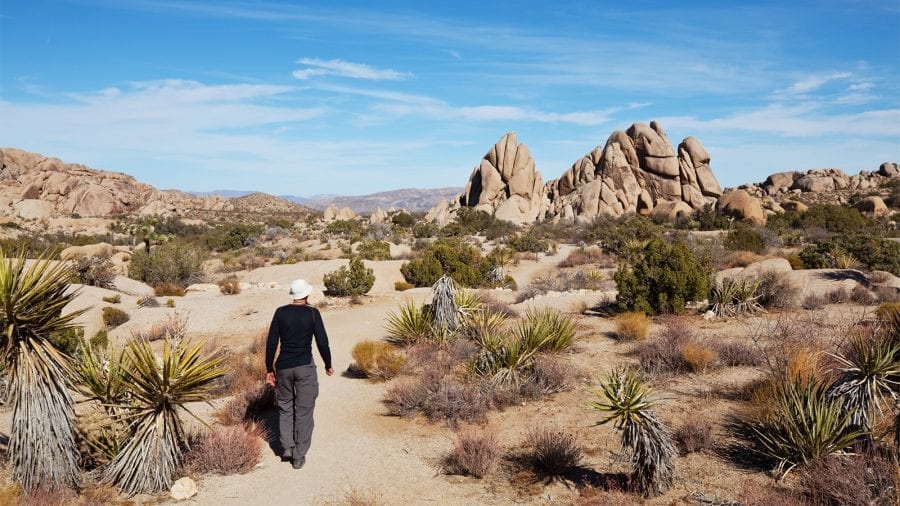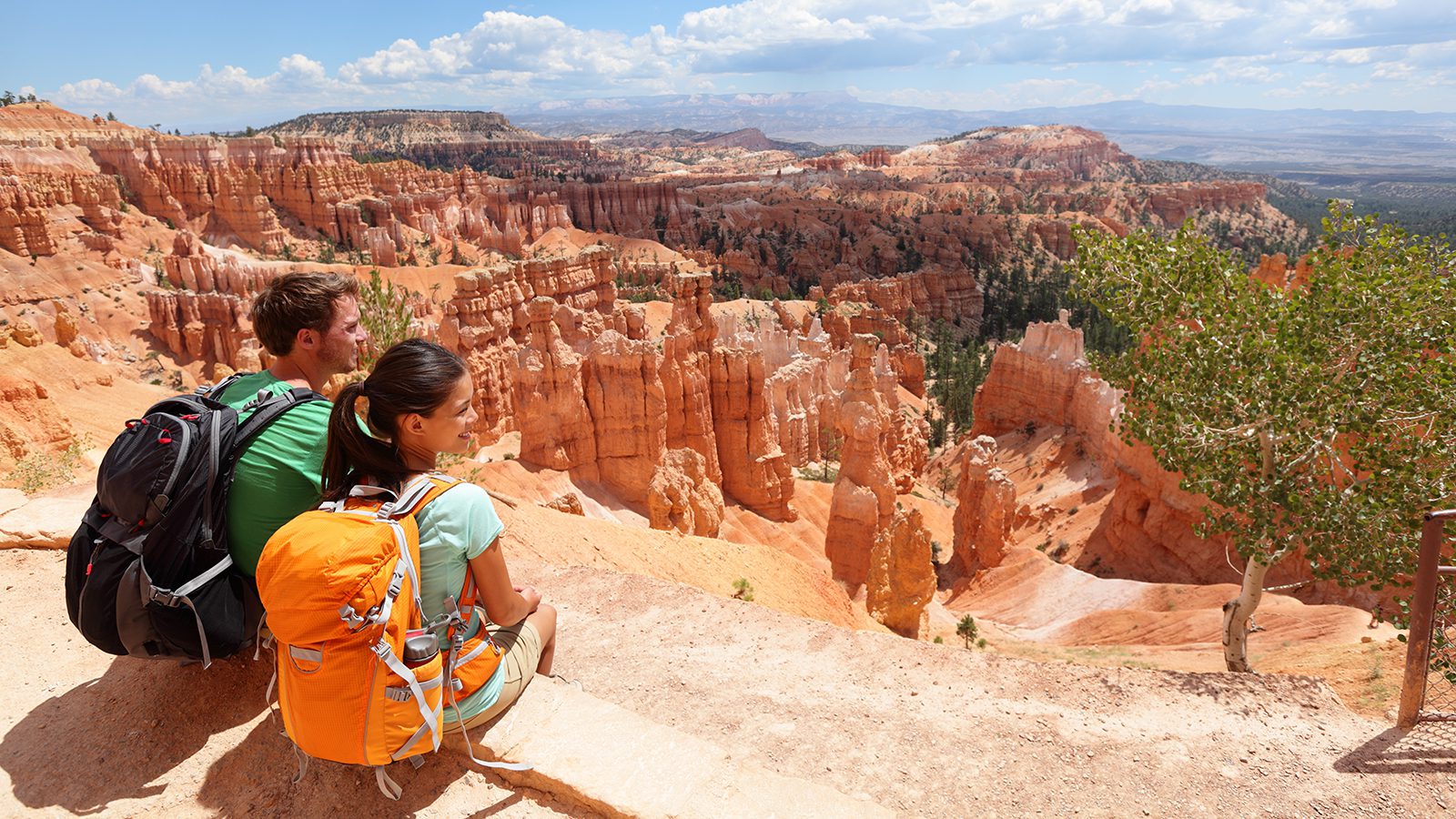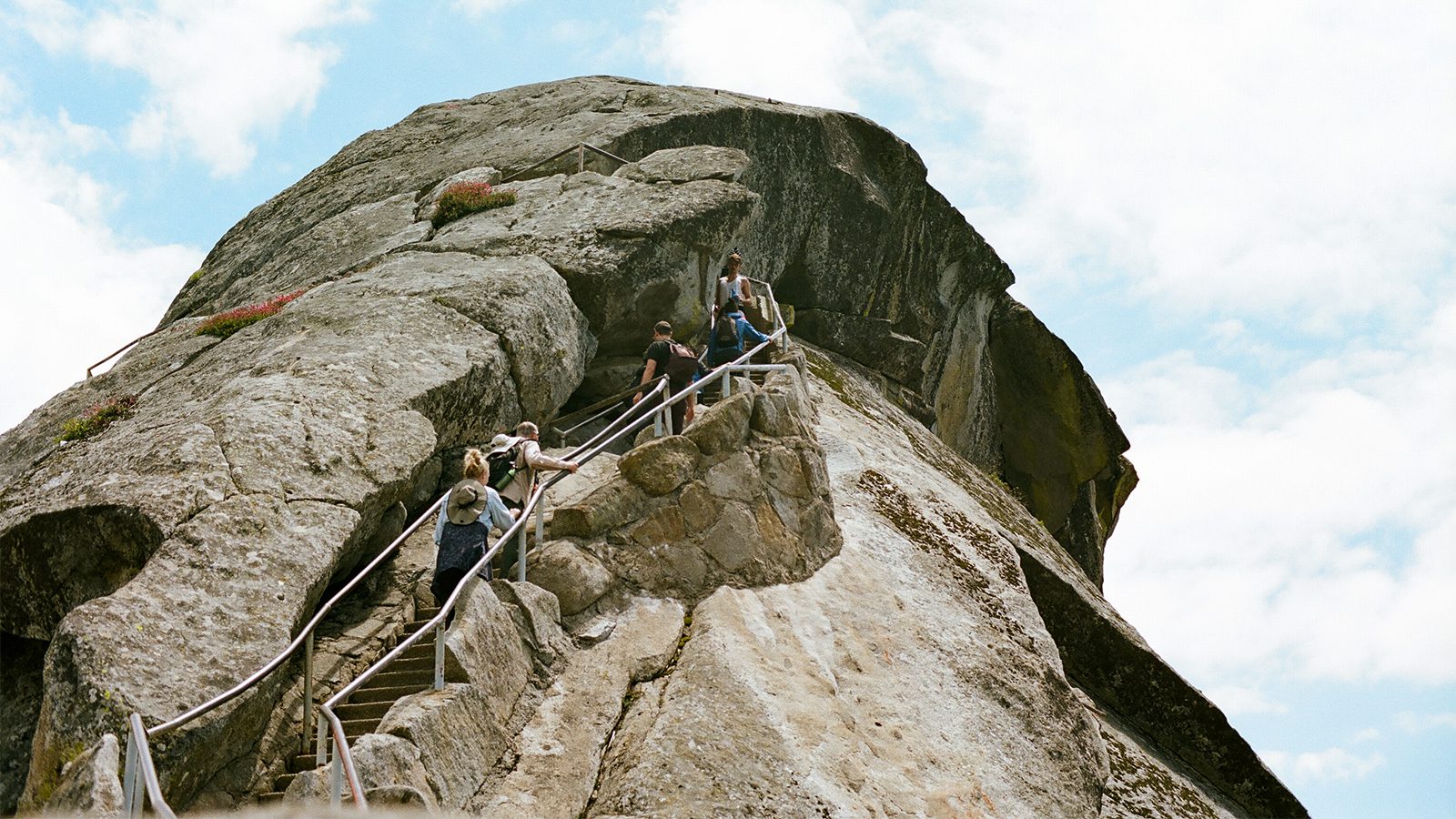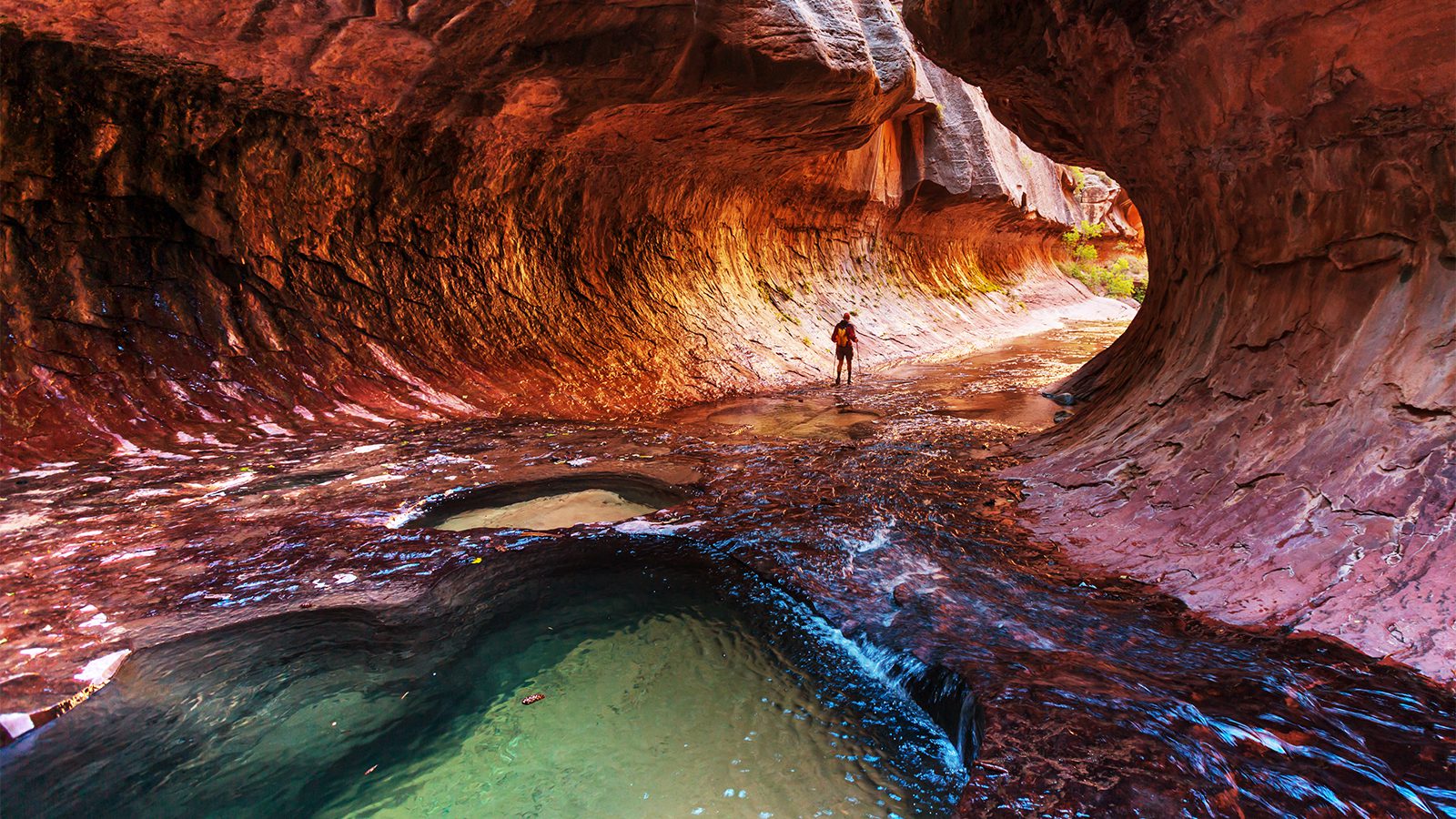
It’s hard to imagine a better way to enjoy the beauty of Joshua Tree National Park than on foot.
Whether you’re interested in traveling through dense stands of Joshua Trees, past craggy rock formations, or in a cactus garden, here are some of the best hikes in Joshua Tree to check out on your next trip.
Here are the 10 of the best hiking trails in Joshua Tree National Park.
Hidden Valley Nature Trail
- Length : 1 mile
- Difficulty : Easy
- Estimated Time : 30 minutes
- Best Time : September to May
For a quick and casual introduction to some of Joshua Tree’s beautiful natural features, a jaunt along the Hidden Valley Nature Trail is a must-do. It starts out near the Hidden Valley Campgrounds and follows a small path that leads you into a secluded space surrounded by craggy features.
Hidden Valley is also one of the best places to check out if you’re looking to see plenty of typical Joshua Tree flora and fauna. The valley is home to everyone from junipers to cacti and, of course, the park’s namesake Joshua Trees, so it’s a nice option for a quick afternoon or morning walk.
Cholla Cactus Garden Nature Trail
- Length : 0.3 mile
- Difficulty : Easy
- Estimated Time : 30 minutes
- Best Time : September to May
Short but sweet, the Cholla Cactus Garden Nature Trail is the perfect hike for plant-lovers. Offering up a chance to see one of the densest concentrations of teddybear cholla cacti in the park, this quick loop hike along well-manicured boardwalks makes for a great evening activity.
The Cholla Cactus Garden is located at the southernmost edge of the park, so it also provides an opportunity for people to visit this remote, but beautiful section. It’s a particularly convenient hike if you’re staying at Cottonwood Campground, which is just a short drive away.
Skull Rock Nature Trail
- Length : 1.7 miles
- Difficulty : Easy to moderate
- Estimated Time : 1 to 1.5 hours
- Best Time : September to May
A fan favorite for anyone staying at or near the Jumbo Rocks Campground, the Skull Rock Nature Trail is an ideal outing for folks who love scrambling over stunning rock formations.
This quick hike starts right on Park Boulevard and follows a rocky path through some large rock slabs and massive boulders. The trail itself is fairly wide and features only slight hills, however, it’s best to wear a sturdy pair of hiking boots if you’re interested in scrambling off-trail.
Additionally, there are plenty of interpretive signs along the way to help you learn more about the park’s geology as you hike. Toward the middle of the loop, you’ll also get to see the uniquely shaped and aptly named Skull Rock, which makes for an excellent photo opportunity.
Fortynine Palms Oasis Trail
- Length : 3 miles
- Difficulty : Moderate
- Estimated Time : 2 to 3 hours
- Best Time : April and October
A welcome sight in the midday desert heat, the Fortynine Palms Oasis Trail is home to some of the only California fan palms in the park. Although the palms in the oasis were originally planted by ranchers in the early 1900s, they are native to the region and provide a respite for local wildlife during the most intense parts of the summer.
The trail itself is around 3 miles round-trip, and is particularly great to do when the temperatures are still cool in the spring and the fall. While there isn’t too much elevation gain along the way, the path is almost completely in the sun, so it’s not recommended during the summer months unless you hike very early in the morning and bring plenty of water bottles.
Once you’re at the oasis, you can gaze up at the California fan palms and keep an eye out for animals, like the Gila monster and chuckwalla, which like to hang out under the trees.
Ryan Mountain Trail
- Length : 3 miles
- Difficulty : Moderate
- Estimated Time : 2 to 3 hours
- Best Time : September to May
Located right off of Park Boulevard near Ryan and Sheep Pass Campgrounds, the Ryan Mountain Trail is a fan favorite for people looking to get some excellent views of the park.
The trail climbs fairly steeply – about 1,500 feet over just 1.5 miles, one way – and takes you all the way to the top of one of the highest peaks in the central part of the park. Hiking up and down the trail can be challenging for some, so be sure to pack trekking poles to help with your balance.
With that in mind, the trail has minimal shade, so it isn’t ideal for the middle of the summer. Once you’re at the top, however, it offers stunning panoramic vistas of much of Joshua Tree National Park for you to enjoy.
Barker Dam Nature Trail
- Length : 1.1 miles
- Difficulty : Easy
- Estimated Time : 1 hour
- Best Time : April
Home to some of the only standing water in this arid and often inhospitable landscape, the Barker Dam Nature Trail is a unique outing that provides plenty of great opportunities to see some rare flora and fauna.
The trailhead is located near the Hidden Valley Campground and follows a casual 1.1 mile loop-style path around a small body of water known as Barker Dam. Although it’s not technically a dam, the pond does offer excellent habitat for pinyon oak woodlands, Joshua trees, and creosote bush scrub.
Once you arrive, you can sit back and enjoy the view while lounging on the surrounding rocky slabs. Just keep in mind that swimming isn’t allowed in Barker Dam, so you can leave your towel back at camp.
Warren Peak Trail
- Length : 6.3 miles
- Difficulty : Moderate to hard
- Estimated Time : 3 to 4.5 hours
- Best Time : April or October
Situated in the far western portion of the park, the Warren Peak Trail is a great hike for more adventurous travelers that want to stretch their legs during the fall and spring months. The trail is located near the Blackrock Campground and starts off gently along a flat path before beginning the uphill climb.
At the summit of Warren Peak, you can gaze out at the wide expanse of desert that is Joshua Tree National Park, in addition to Big Bear Mountain and San Jacinto Peak nearby.
If you’re up for a bit of a challenge, you can even combine this hike with a side trip along the Panorama Loop Trail for some extra views of the region.
Boy Scout Trail
- Length : 8 miles
- Difficulty : Hard
- Estimated Time : 6 hours
- Best Time : April or October
One of the best single-day thru-hikes in the park, the Boy Scout Trail starts near the Indian Cove Campground and ends on Park Boulevard near the Hidden Valley Campground.
Over the course of 8 miles, the trail gives you the chance to see some of the more remote sections of Joshua Tree National Park. It brings you into the Wonderland of Rocks area, which is truly a wonder to behold and allows you to get away from the crowds, even in the middle of the busy season.
It’s important to note that you’ll have to drop a car off at your destination in order to complete this trail as a thru-hike. Alternatively, you can turn it into an overnight backpacking trip and complete the Boy Scout Trail as an out-and-back hike.
California Hiking and Riding Trail
- Length : 35 miles
- Difficulty : Very hard
- Estimated Time : 2 to 3 days
- Best Time : April
The premier multi-night adventure in Joshua Tree National Park, the California Hiking and Riding Trail is an excellent option for experienced backpackers that want to see as much of the park as possible.
Covering some 35 miles of terrain, the trail takes most people about 2 to 3 days to complete as you travel from Blackrock Campground to the North Entrance Station. Along the way, it offers some truly amazing views of the desert landscape, but remember that this terrain is very remote, so come prepared with a first aid kit and other essential survival gear.
Keep in mind that there is no water available on the trail, so you’ll need to cache some at strategic locations before starting your hike. It’s also best to leave a car at the North Entrance Station for when you finish the trail.
Lost Horse Mine Trail
- Length : 4 miles
- Difficulty : Moderate
- Estimated Time : 2 to 3 hours
- Best Time : September to October
For a chance to see one of the often overlooked aspects of Joshua Tree National Park’s history, the Lost Horse Mine Trail is a must-do. During the decades before the region became a national park, the Lost Horse Mine was one of the most successful gold mines in the area.
This 4-mile hike is located near Ryan Campground and is relatively moderate with only 550 feet of elevation change. For a longer hike, you can take the Lost Horse Loop Trail, which is 6.5 miles long, for more views of the area.
When you’re done hiking, you can drive a short distance over to Keys Views and snap a few pics of one of the most iconic vistas in the region.
Gaby Pilson
Gaby is a professional mountain guide with a master’s degree in outdoor education. She works primarily in the polar regions as an expedition guide, though she can be found hiking, climbing, skiing, sailing, or paddling in some of the world’s most amazing places when not at work.


